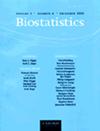实用因果中介分析:扩展非参数估算器,以适应多个中介因素和多个中间混杂因素
IF 1.8
3区 数学
Q3 MATHEMATICAL & COMPUTATIONAL BIOLOGY
引用次数: 0
摘要
中介分析能够提高人们对因果效应机理驱动因素的理解,因此很有吸引力,但现实世界中数据的复杂性给中介分析的成功实施带来了挑战,其中包括:(i) 存在同时影响中介因素和结果的暴露后变量(从而混淆了中介因素与结果之间的关系),这些变量也可能是(ii) 多变量的;(iii) 存在多变量中介因素。在这里,我们的目标是估算幼年时获得第 8 款住房券对青春期患精神情绪障碍风险的间接影响,这种影响通过与邻里贫困、学校环境以及邻里和学校环境的不稳定性相关的中介因素(同时考虑和单独考虑)来实现。干预直接效应和间接效应(IDE/IIE)包含了混淆介导因素-结果关系的暴露后变量,但目前还没有一种易于实施的 IDE/IIE 非参数估计器,可以同时考虑多变量介导因素和多变量暴露后中间混杂因素。缺乏这样一种既能轻松容纳多变量介导因素又能容纳暴露后混杂因素的 IDE/IIE 估计器对于实际分析来说是一个重大限制,因为当单独考虑每个介导因素亚组时,其余的介导因素亚组(或其子集)就会成为暴露后的中间混杂因素。为了弥补这一不足,我们扩展了最近开发的 IDE/IIE 非参数估计方法,以便于同时纳入多变量介导因素和多变量暴露后混杂因素。我们在分析中应用了所提出的估计方法,包括在单独考虑每个中介亚组时,考虑其他可能同时存在的中间变量的策略。本文章由计算机程序翻译,如有差异,请以英文原文为准。
Practical causal mediation analysis: extending nonparametric estimators to accommodate multiple mediators and multiple intermediate confounders
Mediation analysis is appealing for its ability to improve understanding of the mechanistic drivers of causal effects, but real-world data complexities challenge its successful implementation, including (i) the existence of post-exposure variables that also affect mediators and outcomes (thus, confounding the mediator-outcome relationship), that may also be (ii) multivariate, and (iii) the existence of multivariate mediators. All three challenges are present in the mediation analysis we consider here, where our goal is to estimate the indirect effects of receiving a Section 8 housing voucher as a young child on the risk of developing a psychiatric mood disorder in adolescence that operate through mediators related to neighborhood poverty, the school environment, and instability of the neighborhood and school environments, considered together and separately. Interventional direct and indirect effects (IDE/IIE) accommodate post-exposure variables that confound the mediator–outcome relationship, but currently, no readily implementable nonparametric estimator for IDE/IIE exists that allows for both multivariate mediators and multivariate post-exposure intermediate confounders. The absence of such an IDE/IIE estimator that can easily accommodate both multivariate mediators and post-exposure confounders represents a significant limitation for real-world analyses, because when considering each mediator subgroup separately, the remaining mediator subgroups (or a subset of them) become post-exposure intermediate confounders. We address this gap by extending a recently developed nonparametric estimator for the IDE/IIE to allow for easy incorporation of multivariate mediators and multivariate post-exposure confounders simultaneously. We apply the proposed estimation approach to our analysis, including walking through a strategy to account for other, possibly co-occurring intermediate variables when considering each mediator subgroup separately.
求助全文
通过发布文献求助,成功后即可免费获取论文全文。
去求助
来源期刊

Biostatistics
生物-数学与计算生物学
CiteScore
5.10
自引率
4.80%
发文量
45
审稿时长
6-12 weeks
期刊介绍:
Among the important scientific developments of the 20th century is the explosive growth in statistical reasoning and methods for application to studies of human health. Examples include developments in likelihood methods for inference, epidemiologic statistics, clinical trials, survival analysis, and statistical genetics. Substantive problems in public health and biomedical research have fueled the development of statistical methods, which in turn have improved our ability to draw valid inferences from data. The objective of Biostatistics is to advance statistical science and its application to problems of human health and disease, with the ultimate goal of advancing the public''s health.
 求助内容:
求助内容: 应助结果提醒方式:
应助结果提醒方式:


